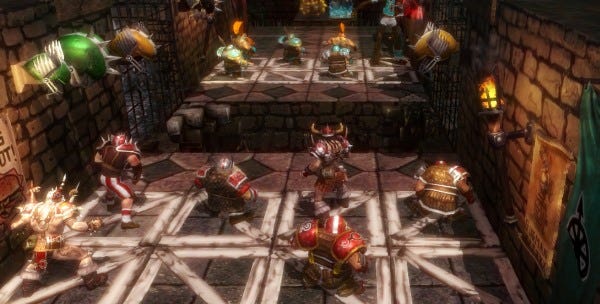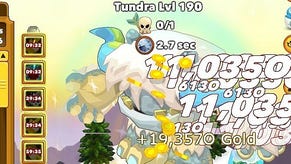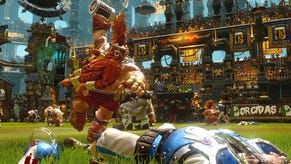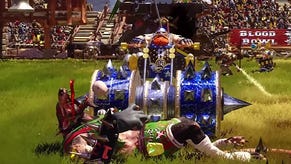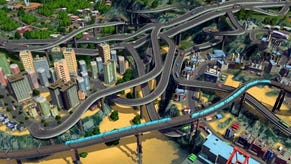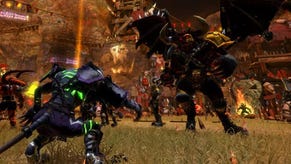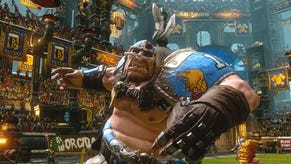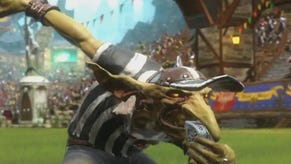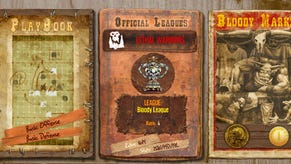Wot I Think: Dungeonbowl
Booby trapped
I’ve always wanted to try Blood Bowl, mostly due to Kieron’s amazing diary of his Skaven team’s inaugural season, so you can imagine my delight when Jim asked me to review stand-alone expansion Dungeonbowl. At last! I was so happy I tucked my t-shirt over my face and performed the traditional foot-to-ball “Frivolous Dance”.
My flat’s a bit small for it, mind, and I ended up putting my foot in my dinner, but the point is I went into Dungeonbowl with an open mind. Also, a sock that smelled of beef. Both of which were probably unwise.
Do you know 2009 video game Blood Bowl? I’ll just bring you to speed. For some reason too facile to explain, every race in the Warhammer universe, from dwarves to drow, is competing in a laughably corrupt interpretation of American football. Good things about Blood Bowl include it being solid turn-based strategy, and also that it boasts team persistency, so your sportsmen and women can grow in experience. Even better things about Blood Bowl include death, so you can lose your star player, permanently, when a treeman sits on them.
Blood Bowl’s also a faithful conversion of the 80s board game of the same name. Having expanded their PC port of Blood Bowl twice already, developers Cyanide have, this month, moved on to the filthier pastures of Dungeonbowl. Which is what we’re reviewing here.

Now, this is where it gets a little esoteric. Dungeonbowl was originally released in 1989 as an expansion for the 2nd edition of the Blood Bowl board game, and, frankly, it’s as mad as a bag of hats. If Blood Bowl riffs on American Football, Dungeonbowl riffs off a bunch of whisky-slicked jocks trying to organise a pick-up game in the middle of a frat party.
Organised by the Warhammer world’s great (and unemployed, I suspect) Colleges of Magic, Dungeonbowl is like the sport of Blood Bowl, except it takes place in a cramped, asymmetrical dungeon, teams are built from an indistinct grab bag of races and you have no idea where the ball is.
On each Dungeonbowl map are a series of chests. The ball is in one of them, determined randomly. Opening any of the others, though, will see your athlete being flattened by an explosion. And since we’re sticking with Blood Bowl’s rules for knockdowns, opening any of the chests and receiving an injury in this way ends your turn early.
Doesn’t that sound like fun.

Also to be found in the sprawling dungeon are teleporter tiles, which will randomly dump you out at one of the other teleporter tiles. Unless you roll a 1 on a D6, at which point your player is removed from the game. Players are also warped out of the match if they’re knocked into any of the dungeon’s inexplicable tentacle pits or lava gutters, something which can be unreliably performed using Blood Bowl’s original block dice.
In fact, the entireity of Blood Bowl’s rules are wielded very awkwardly by Dungeonbowl, as if the game were trying to hammer a nail with a banana. The moment the ball’s fumbled into a narrow corridor where both teams have a few players, the entire game shrinks into a cross between a mosh pit and human chess.
I’ll just clarify this. The original Blood Bowl was built around a system where when one player tackles another, anything could happen. The field was also so large that it made sense for players to be unable to move through each other, and picking up the ball was made harder if it was at the feet of an opponent.

In other words, when you remove players’ ability to maneuver - in some grimy dungeon alley, say - the game becomes a farce.
“Do you want to try and pick up the ball,” asks the game. “You’ve got one guy in this group that can reach it. You can do it on a 5+.”
“OK,” you say.
“Great,” says the game. “You didn’t pick up the ball.”
“That’s OK,” you say. “I wasn’t planning on having any fun today anyway.”
“Sorry. You still have a guy who can act, here, though.”
“Where?”
“Here. The dwarf next to the other dwarf.”
“I thought I moved both of them?” you bemoan. “Hang on. I’m getting another beer.”
“I wish I could drink,” says Dungeonbowl. “But I am only a computer game.”

To clarify, it’s not the game’s Great Wizards that are at fault, here. They conjured a perfectly acceptable, bonkers bloodsport, that might have made a good video game in its own right. No, the fault lies with whatever sherbet-powered longhairs designed Dungeonbowl back in the 80s. The Blood Bowl rules were designed for a wide-open arena, with more space than you could conceivably cover. They simply don’t work as well in an enclosed space.
Which plays into Dungeonbowl’s team management. Rather than a race, you pick your college. You’ve got the pick of the Bright College, Light College and Rainbow College, with Cyanide mumbling inconsequentially about adding other colleges later. Now, nevermind what you know about Warhammer lore, your choice of college simply affects which three Blood Bowl races your team is assembled from.
Bright College gets Humans, Dwarves and Norse. Light College gets Halflings, Dwarves and Norse. Rainbow gets Halfings, Humans and Elves.
If this sounds dry compared to Blood Bowl: Legendary Edition’s roster of 20 unique races (or the forthcoming Chaos Edition’s 23), that’s because it is. No, it’s worse than dry, it’s picking up your drink at a party and tasting somebody else’s water, because the pride and the quiet thrill that comes from Blood Bowl’s asymmetry is dissolved here. At the risk of sounding just a tiny bit like a fascist, it’s much better to keep the races pure. At the risk of sounding even more like a fascist, that wouldn’t work here, of course, because some of them are just more suited to dungeons than others.
This might be a good time to mention that Dungeonbowl has no single-player component. You get online play, where you can manage a team, LAN and Hotseat, and that’s it. Which makes me suspect that Cyanide knew Dungeonbowl was a turkey from quite early on, and attempted to elbow out the door at as little cost as possible.
So that’s that, then. Don’t buy Dungeonbowl, even if you love Blood Bowl. It’s a lateral step in entirely the wrong direction, placing one foot squarely in its own dinner.
...and with that said, I’ll just remove my critic’s cap for a minute. This game was, perhaps, a poisoned chalice for Cyanide. Assuming the Games Workshop license meant they couldn’t change Dungeonbowl’s rules, its madcappery is simply more suited to a board game than a video game. Which isn’t to say the game isn’t full of other, more tedious mistakes. Picking out your own team’s members from a dungeon full of colourful scenery is both tricky and tedious. Remembering which have acted is worse. No word of a lie, it’s simplest to sling the camera low to the ground and point it at walls, so your team members on the other side show up in silhouettes of their colour.
(DOESN’T THAT SOUND LIKE FUN.)
But yeah, back to the poisoned chalice thing. If we look at the aspects of Blood Bowl the PC community’s latched onto, it’s the team management, persistent leagues and the strategy. Take a look at the Blood Bowl fan wiki and you’ll find robust musings on every single unit.

Dungeonbowl? It was about the tabletop thing. Laughing at your opponent when something goes wrong, rearranging the miniatures into teams you haven’t seen before, and giving you more toys to feature in your Blood Bowl games as you saw fit. Sure, according to the rulebook, Dungeonbowl’s a different game, hence the expandalone status of the PC port. But if I was a kid playing it in the 1989s? I’d work out some way to have my team playing two concurrent matches of Blood Bowl, one above ground, one beneath it.
Which is neither here nor there, because this is a PC game, and it can’t drink beer, nor can it be combined with your other games as you see fit.
Yet.
Ooh, I just gave myself shivers. Don’t buy Dungeonbowl, everybody!
